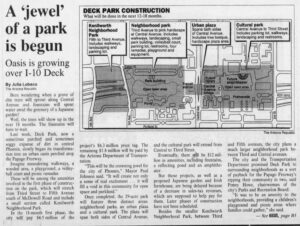The Last Mile
Donna Reiner has written many articles over the years for the Arizona Republic and others about Phoenix history and memorials. She is a regular contributor to our newsletter. This month Donna tells us about Margaret T. Hance Park, over the last mile of I-10 to be built, and the final connecting point between the Pacific and Atlantic oceans via that freeway.
When plans began for the design of the last mile of Interstate 10, no one could have imagined that it would first take so long to come to fruition. And even more so, once the plans were finalized, and construction began, that costs, budget constraints, and many of the usual things that are associated with a large project, would ultimately change much of the proposed landscape.
In 1972, grand plans for the “Central Avenue Park” were approved with the proposed heliocoils of the new Papago Freeway to tower over it. The lushly landscaped park would include bike paths, a living museum operated by the Central Arizona Historical Society and located at the Shackelford House, numerous recreational facilities, and a visitor center. On paper, this would be a park where Phoenicians and visitors would gather for fun, recreation, and festivals. However, a dark cloud hovered over this proposal in the form of the failure for the freeway design to be approved. Of course, the land had been purchased and cleared of houses leaving what looked like a dead zone right through the middle of residential Phoenix.
Back to the drawing board until 1984 with a new plan for a park which would be on top of an underground portion of the freeway. While the park would be depressed below street level, the design concept intended that what was once a dead zone would now be a “major unifying element” for the surrounding neighborhoods and central Phoenix. The plans once again proposed recreation and open space, but this time the new and improved version included an exhibit area for arts and crafts, a sculpture garden, water features, tree bosque, amphitheatre, and even an active recreation area that might have a racketball court. The idea was to re-establish a cohesive community that had been ripped apart by the removal of hundreds of homes.
The city created an advisory committee in 1985 to move the project forward. This committee presented a draft master plan to city council in March 1986. Despite city approval, unresolved land use issues caused some problems which were resolved that fall. In the mean time, staff suggested that an arts district be integrated into the park. Neighbors were cautious, but generally supportive. A freeway underground was a far better option than one towering above. And the park with the proposed amenities would be a nice addition.
The deck park concept still had more hoops to jump through before finally opening. Much larger than similar parks in Seattle and Washington, DC, it was being billed as the “playground of Phoenix.” A Japanese Tea Garden and then an Irish farmhouse to celebrate two of Phoenix’s sister cities were suggested to be included. The city even proposed placing the new central main library in the park. Ideas continued to swirl around all while the actual construction of the underground portion of I-10 finally began in the fall of 1988. Newspaper articles announced that the proposed opening of the tunnel and the park would be in early 1990.
Of course, things don’t always go according to schedule, costs, and plans. Work on the park finally started in January 1991. But budget constraints reduced the amenities. So the fountains and amphitheatre were not built and construction of the Irish farmhouse and the Japanese Tea Garden were postponed. The three original sections of this grand park: cultural, urban plaza (around Central Avenue) and neighborhood (west side) are not something most visitors or Phoenicians could even grasp today. While the library was constructed on the edge of the deck, by the urban plaza section, the other sections are distinct by contour of the land. The Japanese Tea Garden is cultural, but it is on the west end of the park and the Irish Cultural Center is on the southern side of what was to the urban plaza. The Phoenix Center for the Arts, a marvelous cultural center, is a bookend on the east end of the park.
So after twenty years, the Margaret T. Hance Park was dedicated on Saturday, April 25, 1992.



